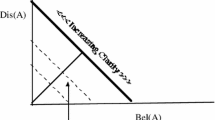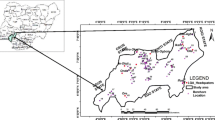Abstract
The evidential belief function (EBF) provides an adequate theoretical basis for managing uncertainties in exploration data integration. The EBF can be used to represent uncertainties in the reasoning process and provides the capability of distinguishing between lack of information and negative information. This capability is desirable when combining diverse data sets, which often vary in spatial resolution and spatial extent. The uncertainties associated with data and propositions can be represented naturally and consistently using belief functions. Hence, using the EBF approach can provide a realistic quantitative picture of the target proposition.
Similar content being viewed by others
References
Agterberg, F.P., 1989, Computer programs for mineral exploration: Science, vol. 245, p. 76–81.
An, P., 1992, Spatial reasoning techniques and integration of geophysical and geological information for resource exploration: Winnipeg, The University of Manitoba, Ph.D. dissertation, 162 p.
An, P., and Moon, W.M., 1992, A knowledge-based approach of integrating geophysical and geological data sets. Working Notes, Intelligent Scientific Computation, AAAI Fall Symposium, Cambridge, Massachusetts, U.S.A. (also included in AAAI Technical Report, FF-92-01).
An, P., Moon, W.M., and Rencz, A., 1991, Integration of geological, and remote sensing data using fuzzy set theory: Canadian Journal of Exploration Geophysics, v. 27, No. 1, p. 1–11.
Bamburak, J.D., 1990, Metallic mines and mineral deposits of Manitoba, Energy and Mines, Provincial Government of Manitoba, Canada, Open File Report OF90-2.
Bonham-Carter, G.F., Agterberg, F.P., and Wright, D.F., 1988. Integration of geological datasets for gold exploration in Nova Scotia: Photogrammetric Engineering and Remote Sensing, v. 54, No. 11, p. 1585–1592.
Bonham-Carter, G.F., Agterberg, F.P., and Wright, D.F., 1989, Weights of evidence modeling: A new approach to mapping mineral potential,in Agterberg, F.P., and Bonham-Carter, G.F., eds., Statistical Applications in the Earth Sciences: Geological Survey of Canada, Paper 89-9, p. 171–183.
Campbell, F.H.A., 1969, Turnbull Lake area: Summary of geological field work, Department of Energy and Mines, Provincial Government of Manitoba, Canada, Geological Paper 4/69, p. 15–20.
Chevillard, R., and Genaile, B., 1970. Ground horizontal loop EM survey map: Department of Energy and Mines, Provincial Government of Manitoba, Canada, Assessment file 91436.
Clark, G.S., 1980, Rubidium-strontium geochronology in the Lynn Lake greenstone belt, Northwestern Manitoba: Manitoba Mineral resources Division, Geological Paper GP80-2.
Dempster, A.P., 1967, Upper and lower probabilities induced by a multivalued mappin: Annals of Mathematical Statistics, v. 38, p. 325–339.
—, 1968. A generalization of Bayesian inference: Journal of the Royal Statistical Society, series B, v. 30, p. 205–247.
Geological Survey of Canada, 1984, Airborne magnetic total field map, Geological Survey of Canada. Open File Report 1047.
Gilbert, H.P., Syme, E.C., and Zwanzig, H.V., 1980, Geology of the metavolcanic and volcaniclastic metasedimentary rocks in the Lynn Lake area: Manitoba Mineral Resources Division, Geological Paper GP-1.
International Nickel Cooperation (INCO), 1954, Preliminary report of the airborne EM survey over Lynn Lake-Farley Lake area. Manitoba, Canada.
Moon, W.M., 1990, Integration of geophysical and geological data using evidential belief function: IEEE Transactions on Geoscience and Remote Sensing, v. 28, p. 711–720.
—, 1993, On mathematical representation and integration of multiple spatial geoscience data sets: Canadian Journal of Remote Sensing, v. 19, p. 251–255.
Nielson, E., and Graham, D.C., 1985, Preliminary results of till petrographical and till geochemical, studies at Farley Lake: Geological Services, Manitoba Energy and Mines, Open File Report OF86-2.
Pinsent, R.H., 1980, Nickel-copper mineralization in the Lynn Lake gabbro: Department of Energy and Mines, Provincial Government of Manitoba, Canada, Economic Geology Report, ER79-3.
Shafer, G., 1976, A mathematical theory of evidence: Princeton, N.J., Princeton University Press, p. 10–60.
Singer, D.A., and Kouda, R., 1988, Integrating spatial and frequency information in search for Kuroko deposits of Hokuroko district, Japan: Economic Geology, v. 83, no. 1, p. 18–29.
Syme, E.C., 1985, Geochemistry of metavolcanic rocks in the Lynn Lake Belt: Manitoba Mineral Resources Division, Geological Report GR84-1.
Author information
Authors and Affiliations
Rights and permissions
About this article
Cite this article
An, P., Moon, W.M. & Bonham-Carter, G.F. Uncertainty management in integration of exploration data using the belief function. Nat Resour Res 3, 60–71 (1994). https://doi.org/10.1007/BF02261716
Received:
Revised:
Accepted:
Issue Date:
DOI: https://doi.org/10.1007/BF02261716




